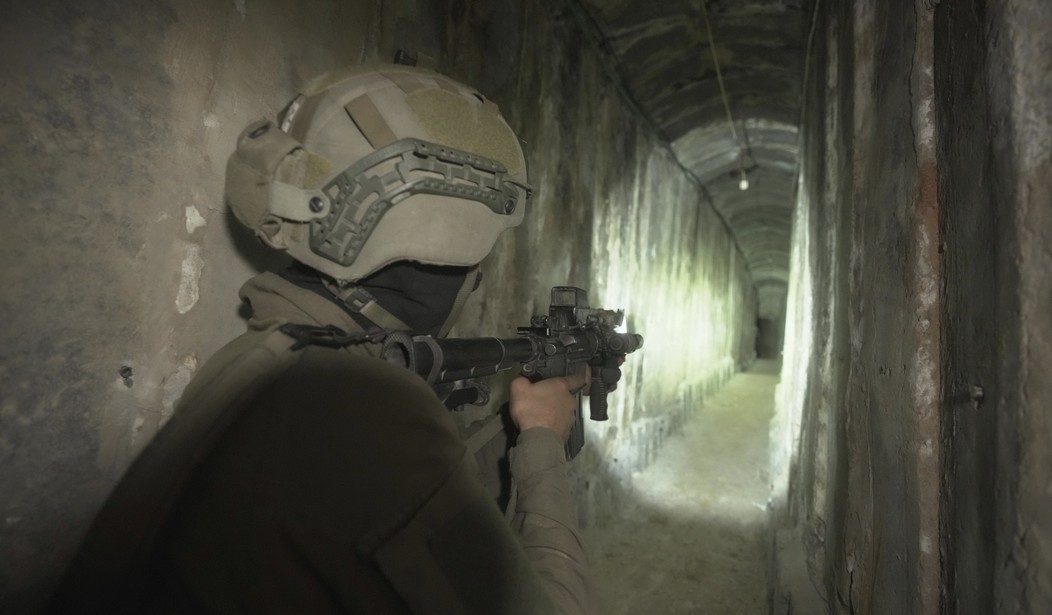French president Emmanuel Macron recently declared that it would take ten years for Israel to destroy Hamas. Noted Kabul bug-out strategist and American-abandoner Lloyd Austin publicly advised that the IDF could never accomplish that goal without being a lot nicer to people.
What do the Israelis think? In both words and action, they have made clear that they see Khan Younis as the key to the war. In the last couple of days, the IDF has sent armored units to surround the presumed fallback position of Hamas’ command and control operations, and have intensified air strikes to reduce Hamas’ escape routes. After seizing Gaza City and Jabaliya, Khan Younis is the last ground where Hamas can survive, the Wall Street Journal quotes analysts’ conclusions — and that’s why the IDF will face its toughest test of the war in that city:
Israeli forces closed in on the city of Khan Younis in the Gaza Strip on Tuesday, engaging in close combat with Hamas fighters in what could be the decisive battle of the two-month-old war, while residents fled from the fighting amid a worsening humanitarian plight.
Hamas, a U.S.-designated terrorist group, is defending its last major bastion in Gaza, where Israel believes the group’s leaders are hiding and holding hostages, after Israeli forces drove the militants and much of the population out of Gaza City in the enclave’s north. …
Analysts say Israeli forces could face tougher resistance from Hamas in Khan Younis than they did in the north. If Hamas loses Khan Younis too, its surviving fighters could end up in small areas in central Gaza and near the Egyptian border, surrounded by Israeli troops.
“If Hamas loses Khan Younis, they are done. They may have some enclaves there, but they will lose their centers of gravity,” said Kobi Michael, a senior fellow at The Institute for National Security Studies, a security think tank in Tel Aviv.
Color me a wee bit skeptical on both sides of this claim. First, on the degree of difficulty: we heard this about Gaza City too. Hamas clearly had diversified its operations in all three locations, but Gaza City was the obvious seat of power in the Strip, and Hamas’ public command was centered there. The IDF was supposed to get decimated in a well-planned defensive gauntlet in the capital, but that bloodbath never materialized, thanks to the IDF’s improved tactics and intel, as well as the obvious advantages of combined warfare. It didn’t take very long to force Hamas out of Gaza City at all, and only a little longer to dislodge them from Jabaliya and the key Gaza City suburb Shejaia, a mission that the IDF apparently fully accomplished only in the last couple of days.
But will sacking Hamas’ infrastructure in Khan Younis mean that Hamas is “done”? That seems unlikely, given their international resources and their extensive burrows. ISIS lost Raqqa but still exists, thanks to its fallback to a cell-based terror network rather than a self-professed “state” (caliphate) that holds territory. Assuming that Hamas can’t fall back again to Rafah at the southernmost end of the Gaza Strip, transitioning to that model will at least leave them with options for attacking Israel on a much smaller scale, while preserving influence on the political environment in Gaza. Any occupying force — Israeli or Sunni Arab — will be forced to fight an insurgency, likely a never-ending one.
That is, the insurgency will last as long as the tunnels do. Jazz wrote earlier about the debate in Israel about flooding the Hamas tunnel system with seawater, a strategy that has prompted criticisms about the potential for bad environmental consequences, especially to Gaza’s freshwater aquifer. This is not a good-faith argument, as Hamas has done next to nothing to make proper use of, or protect, the aquifer. It used billions of dollars in foreign aid (as of 2021) meant for that development to build their tunnel system and kept Gaza reliant on water imports from Israel instead. They also used pipes intended for water delivery as rocket launchers, a practice of years that has escalated in this conflict.
The only way to destroy Hamas is to destroy those tunnels, and flooding them with seawater is both the most humane and effective method for accomplishing that mission. (Five years ago, via Jim Maruschak, the IDF used cement in southern Lebanon on Hezbollah tunnels into Israel to comic effect, but the scale of the Gaza tunnel system makes that choice impractical.) Using troops or explosives to destroy the tunnels would be too dangerous and much more risky to legit civilian structures under which they run. It will take several weeks of pumping, so no one would risk drowning. It would, however, eventually force all Hamas personnel to the surface and it would eliminate their covert transit system throughout Gaza for good.
One way or another, the tunnels have to be made impassable in order to destroy Hamas, and Israel knows this. If Israel captures Khan Younis while making the tunnels impassable over the next several weeks, this really could be a decisive battle. ISIS had the advantage of a very large territory in its efforts to convert back to an al-Qaeda model after the liberation of Raqqa. Gaza is too dense for Hamas to effectively reorganize in the ruins above ground, and the IDF will be far too engaged on the ground to allow it.
And there may not be that many left to reorganize either if Hamas and/or the Gazans don’t capitulate soon. The IDF reports now that they have struck into the “heart” of Khan Younis, and now estimate that a third of Hamas’ terrorists have been killed in the war:
Several hundred Hamas terrorists were killed on Sunday, marking one of the deadliest for Hamas’s forces, and bringing the number of dead Hamas forces to around 6,000 with thousands wounded as well.
Based on these estimates, Hamas is assessed as having around 20,000 remaining potential fighters of its original 30,000. …
Based on the combined attacks, IDF Southern Command Chief Maj. Gen. Yaron Finkleman said, “We are in the heart of Jabalia, the heart of Shejaia, and as of last night, the heart of Khan Younis. We are in the most intense day since the start of the invasion – in terms of the number of killed terrorists, the number of battles, and the volume of fire brought to bear by ground and air forces. We intend to continue to attack and to deepen our achievements.”
A lot of those left will be in the tunnels, waiting for a good moment to ambush IDF units. Don’t be surprised if the Israelis turn on the pumps soon to force them out into the open. It’s not going to take ten years for that to happen, and Hamas better not even count on ten weeks.
Also, the latest episode of The Ed Morrissey Show podcast is now up! Today’s show features:
- A.J. Kaufman, managing editor of the Tri-Cities Business Journal, and I discuss the new climate of a very old hatred, and what may come next.
- A rising tide of violence and campaign of intimidation against Jews keeps escalating. In Philadelphia, a mob targeted a Jewish-owned business, while angry activists demanded a terrorist ‘intifada revolution’ in New York City.
- What does this ferocious climate of hatred entail — and will it keep escalating?
The Ed Morrissey Show is now a fully downloadable and streamable show at Spotify, Apple Podcasts, the TEMS Podcast YouTube channel, and on Rumble and our own in-house portal at the #TEMS page!








Join the conversation as a VIP Member